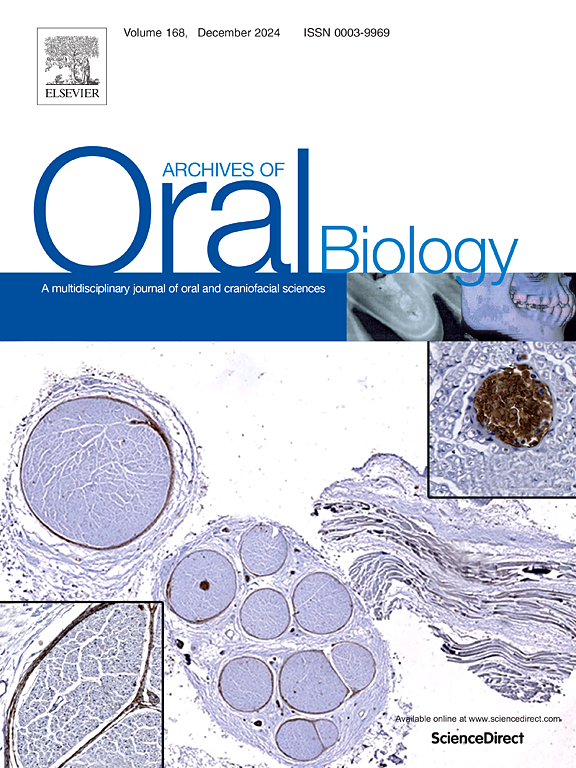PCSK9 is a passenger gene in head and neck cancer with minimal pathological influence
IF 2.1
4区 医学
Q2 DENTISTRY, ORAL SURGERY & MEDICINE
引用次数: 0
Abstract
Objectives
In this study, we aimed to explore the pathological effects of PCSK9 in head and neck cancer (HNC) by ablating its expression using the CRISPR-Cas9 knockout system.
Design
To investigate the clinical importance of PCSK9 in HNC, in silico analysis was performed using datasets from the GEO database and the UALCAN database. To evaluate the role of PCSK9 in HNC pathogenesis, both CRISPR-Cas9 knockout system and pharmacological inhibition were employed to ablate PCSK9 expression in HNC cell lines. The impact of PCSK9 on cellular growth and proliferation was assessed using Cell Counting Kit-8, soft agar, and clonogenic assays in a 2D culture model, as well as a hanging drop spheroid formation assay with live/dead staining in a 3D culture model. The involvement of PCSK9 in apoptosis induction was evaluated by detecting c-PARP expression through Western blotting, measuring the sub-G1 population via cell cycle assay, and verifying the Annexin V-positive population. Finally, changes in metastatic profiles associated with fluctuations in PCSK9 expression were examined using wound healing and transwell migration/invasion assays.
Results
In in silico analysis results, PCSK9 appeared to be related to the progression of HNC. However, experimental results demonstrated that PCSK9 plays a minimal role in cancer cell proliferation, anchorage-independent growth, colony formation capacity, in 2D cultures, as well as spheroidal growth in 3D cultures, and apoptosis induction. Furthermore, PCSK9 marginally influenced wound closure, metastatic potential, and invasive ability.
Conclusion
Collectively, these data suggest that PCSK9 serves a neutral role in HNC, functioning as a passenger gene.
PCSK9在头颈癌中是一个载客基因,病理影响很小
目的利用CRISPR-Cas9基因敲除系统,探讨PCSK9在头颈癌(HNC)中的病理作用。为了探讨PCSK9在HNC中的临床意义,我们使用GEO数据库和UALCAN数据库的数据集进行了计算机分析。为了评估PCSK9在HNC发病机制中的作用,我们采用CRISPR-Cas9敲除系统和药物抑制两种方法来降低PCSK9在HNC细胞系中的表达。PCSK9对细胞生长和增殖的影响通过细胞计数试剂盒-8、软琼脂和克隆实验在2D培养模型中进行评估,以及在3D培养模型中进行活/死染色的悬挂滴球形成实验。通过Western blotting检测c-PARP表达,通过细胞周期测定测定亚g1群体,并验证Annexin v阳性群体,评估PCSK9在诱导凋亡中的作用。最后,通过伤口愈合和跨井迁移/侵袭试验,研究了与PCSK9表达波动相关的转移谱变化。结果PCSK9与HNC的进展相关。然而,实验结果表明,PCSK9在2D培养中对癌细胞增殖、不依赖锚定生长、集落形成能力以及3D培养中的球体生长和诱导凋亡的作用很小。此外,PCSK9对伤口闭合、转移潜力和侵袭能力有轻微影响。综上所述,这些数据表明PCSK9在HNC中起中性作用,作为一个客运基因。
本文章由计算机程序翻译,如有差异,请以英文原文为准。
求助全文
约1分钟内获得全文
求助全文
来源期刊

Archives of oral biology
医学-牙科与口腔外科
CiteScore
5.10
自引率
3.30%
发文量
177
审稿时长
26 days
期刊介绍:
Archives of Oral Biology is an international journal which aims to publish papers of the highest scientific quality in the oral and craniofacial sciences. The journal is particularly interested in research which advances knowledge in the mechanisms of craniofacial development and disease, including:
Cell and molecular biology
Molecular genetics
Immunology
Pathogenesis
Cellular microbiology
Embryology
Syndromology
Forensic dentistry
 求助内容:
求助内容: 应助结果提醒方式:
应助结果提醒方式:


